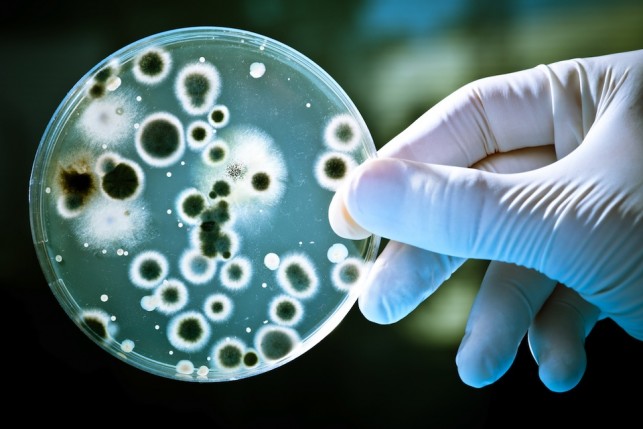Mold & Your Health
Like all organisms, moisture is essential for mold to live and grow. Common causes of water intrusion include, water and/or sewer pipe damage, damaged roof or improperly installed shingles, severe weather such as tornadoes or floods, improper grading around the property, leaking or unproperly installed appliances or high indoor humidity. If your home has experienced any of these, chances are mold will not be far behind.

Mold grows best at room temperature, so your house is a perfect place for mold to thrive and flourish. You could see suspicious spots on your walls, ceilings, floors, that change color, shape or grow in size over time. You may also notice a musty smell indicating that mold could be present. Mold can grow on many surfaces including: tile, carpet, grout, sheet rock, wood, paint, plaster, and fabric. Although molds often originate in one area, spores can spread through the rest of your home. Mold spores that are set adrift in your home will find an appropriate place to live and grow, like bathrooms and kitchens, which contain adequate food and moisture.
Health Concerns
Some people are extremely sensitive to molds. For these people, exposure to molds can cause symptoms such as nasal stuffiness, eye irritation, wheezing, headaches, or skin irritation. Some people, such as those with serious allergies to molds, may have more severe reactions. Severe reactions may occur to those exposed to large amounts of molds, causing reactions may include fever and shortness of breath. Some people with asthma or chronic lung illnesses, such as obstructive lung disease, may report trouble breathing or could possibly develop mold infections in their lungs.

“Black Mold” is not a species or specific type of mold, nor is “Toxic Mold”. Sometimes the news media uses these terms to refer to molds that may produce mycotoxins or for one mold species, Stachybotrys. The known health effects from exposure to Stachybotrys are similar to other common molds, but have been inconclusively associated with more severe health effects in some people.
Stachybotrys has been considered a contributing factor in allergies, asthma, and bronchitis. The Center For Disease Control claims that this type of mold is linked to deaths from respiratory bleeding, and it is linked to various lung disorders as well. Certainly anyone with an illness affecting their immune system would need to be wary.
You cannot identify the type of mold in your home with a photograph or with the naked eye, since most molds look very similar. The only way to tell for sure what type of mold you are dealing with is to have your property tested. Remember, it’s the types of mold and the amounts that you inhale that matter. Small amounts of certain types of molds can be extremely harmful.
Radon & Your Health
Radon is an invisible, odorless, tasteless radioactive gas and is a naturally-occurring byproduct of the radioactive decay of Uranium in the soil. Elevated indoor levels are found in every state in the US and is by far the greatest single source of radiation exposure to the general public. Your risk of lung cancer increases substantially with exposure to higher radon levels, with lung cancer risk rising 16% per 2.7 pCi/L increase in radon exposure. (World Health Organization, 2009).The EPA recommends homes be fixed if the radon level is 4 pCi/L (picocuries per liter) or more. Because there is no known safe level of exposure to radon, EPA also recommends that Americans consider fixing their home for radon levels between 2 pCi/L and 4 pCi/L. The average radon concentration in the indoor air of America’s homes is about 1.3 pCi/L.According to the US EPA, radon is the second leading cause of lung cancer in the United States, and the leading cause among non-smokers. However, the absolute numbers of radon-induced lung cancers are much larger in people who smoke, or who have smoked in the past, due to a strong combined effect of smoking and radon. The EPA estimates the number of radon-related lung cancers deaths per year at 21,000.
Methamphetamine & Your Health
As the highly addictive drug methamphetamine grows in popularity, so does the chance you could end up buying a “meth house” when you go shopping for real estate. Just how dangerous are these chemicals? At the very least, exposure to meth residues left behind from cooking or smoking may cause symptoms similar to those experienced by meth users – a “contact high” if you will. At the very worst, they can cause cancer or sudden death.
Making or smoking meth leaves behind a dust of chemicals that saturates walls, ceilings, floors and carpets with meth residue as well as mercury, lead, iodine, lithium and poisonous solvents. Exposure to even small amounts of these poisons can damage humans’ nervous systems, liver, and blood production mechanisms.
These toxins are particularly dangerous to young children and fetuses. Kids are especially sensitive to chemical exposure, which can damage developing brains. Babies and toddlers who crawl and put things in their mouths can easily pick up meth residues. Mothers exposed to these chemicals can give birth to babies with developmental delays and other birth defects.
